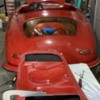Mitch has a better soldering gun than me - I use a 600 watt and get tired of waiting for it as it takes seemingly forever to heat a 10 or 12 gauge connection enough to flow the solder. 
The trouble with using a torch for soldering 1, 2 or 4 gauge cable ends is that it takes so much heat to heat up the cable's and connector's metal mass to accept a solder flow that the cable's outer sheath (the rubber or vinyl covering) will surely begin to melt, if it doesn't downright burn in the process and pull away from the connector. Then, you end up with an ugly-looking connection that is best covered with same-color shrink tube to cover up the burnt ugliness. 
Another alternative (but you still have the excess heat problem) is to use cable terminations specifically designed for soldering, like Fusion Links:
https://allbatterysalesandserv...minal-fusion-406304p
I have faced this same problem a number of times, both at work and at home, and have done just what the Auto Industry figured out decades ago: Crimp it, and then coat the connection with an anti-corrosive spray, like "No Corrode":
https://www.amazon.com/Permate...erosol/dp/B000BOKML2
When I do battery cables, I get a battery, truck or auto electric or HiFi store to crimp the cable ends on for me and I'm done. They use a pneumatic crimper with jaws made specifically for the lug and wire being crimped and a 2 gauge cable should withstand something around a 600 pound pull (that's how the crimper is tested). At most, I add some expanded shrink tube to the cable before the ends are crimped on to provide a little more protection at the crimp, but that's it. I haven't soldered anything bigger than a 10 gauge wire in decades.
I did not crimp the battery end of my most recent cable upgrade because I wanted a special connector that I could not find crimped, but it is a barrel-type I got from a local RV shop that accepts a single 2 gauge and single 10 gauge, similar to this:
https://www.amazon.com/MICTUNI...9720261720&psc=1
Mine has a sleeve or two inside so that when the set-screw is tightened it presses on the sleeve which then presses against the cable, effectively crimping everything together. Expensive, but it works.








